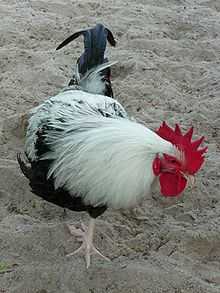Dorking (chicken)
| Dorking | |
|---|---|
 A Silver Grey Dorking rooster. | |
| Other names | Silver Grey Dorking. |
| Country of origin | Italy |
| Traits | |
| Weight | Male: 9lb |
| Female: 7lb | |
| Skin color | White |
| Egg color | White |
| Comb type | Single |
| Classification | |
| APA | Continental |
| ABA | Recognized by the ABA |
|
Chicken Gallus gallus domesticus | |
The Dorking is a breed of chicken that is believed to have originated in Italy during the period of the Roman Empire and was introduced in Britain at the time of the Roman conquest making it one of the oldest English breeds.[1]
History
One of the earliest known mentions of the Dorking was by the Roman agricultural writer Columella during the reign of Julius Caesar. In his text, Rei rusticae libri, he described the breed as, "square-framed, large and broad-breasted, with big heads and small upright combs...the purest breed being five-clawed". Pliny also described a similar bird with an odd number of toes in his Naturalis Historia. Although Caesar noted that poultry was already raised in Britain prior to his invasions in 55–54 BC, the Red Dorking is believed to have been introduced in Great Britain by the Romans at an early date where much of its development continued to take place.[2][3]
They appeared in the first British poultry show in 1845, together with the Sussex breed, which is believed to be derived from the Dorking.[4] The birds are named after the market town of Dorking in Surrey which in the nineteenth century became one of the main centres of production.
They were admitted in to the American Poultry Association's Standard of Perfection in 1874.
Characteristics
The Dorking has a rectangular body with very short, five-toed legs. As with all single comb poultry, the comb points may require protection in extremely cold weather. Dorkings are also well known for their versatility as a breed for both egg and meat production. It is one of the few breeds with red earlobes that produces a white-shelled egg. The skin colour beneath the feathers is white. The standard weight is 9 pounds for a cock, 8 pounds for a cockerel, 7 pounds for a hen, and 6 pounds for a pullet. Furthermore, the breed is very docile. The bird has five recognized varieties: White, Silver-grey, Red, Dark and Cuckoo.(1)
Approximate Weight
| Cock | 4.6 - 6.4 kg | 10.1 - 14.1 lbs |
| Hen | 3.6 - 4.6 kg | 7.9 - 10.1 lbs |
| Rooster | 1.1 - 1.4 kg | 2.4 - 3.1 lbs |
| Hen | 0.9 - 1.1 kg | 2 - 2.4 lbs |
Gallery
- Illustrations by Harrison Weir
-

Coloured Dorking
-

White Dorking
-

Red Dorkings
-

Prize Dark Dorkings
Notes
References
- Éleveur de volailles Spécialiste Dorking. Mark Fletcher. Spezet 29540. France
- Crawford, Roy D. (1990), Poultry breeding and genetics, Elsevier Health Sciences, ISBN 0-444-88557-9
- Dohner, Janet Vorwald (2001), The encyclopedia of historic and endangered livestock and poultry breeds, Yale University Press, pp. 421–423, ISBN 0-300-08880-9
- Lewer, Sidney H. (1927), British poultry and poultry keeping, The Feathered World
- Sturges, Rev. T. W. (1911), The Poultry Manual: A complete guide for the breeder and exhibitor, Macdonald and Evans
External links
| Wikimedia Commons has media related to Dorking (chicken). |
- https://sites.google.com/site/dorkingvolaille/home
- Dorking from an Oklahoma State University website
- Dorking from feathersite.com
- poultryhub.org Fancy Chicken Breeds